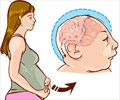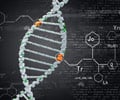
The research by developmental biologists at Tufts University used a tadpole model to show that developing organisms are not genetically "hard-wired" with a set of pre-determined cell movements that result in normal facial features.
Instead, the process of development is more adaptive and robust. Cell groups are able to measure their shape and position relative to other organs and perform the movements and remodelling needed to compensate for significant patterning abnormalities, the study showed.
"A big question has always been, how do complex shapes like the face or the whole embryo put themselves together? We have found that when we created defects in the face experimentally, facial structures move around in various ways and mostly end up in their correct positions," said Michael Levin, Ph.D., senior author on the paper and director of the Center for Regenerative and Developmental Biology in Tufts University's School of Arts and Sciences.
"This suggests that what the genome encodes ultimately is a set of dynamic, flexible behaviours by which the cells are able to make adjustments to build specific complex structures. If we could learn how to bioengineer systems that reliably self-assembled and repaired deviations from the desired target shape, regenerative medicine, robotics, and even space exploration would be transformed."
Previous research had found self-correcting mechanisms in other embryonic processes - though never in the face - but such mechanisms had not been mathematically analysed to understand the precise dynamics of the corrective process.
Advertisement
The Tufts biologists induced craniofacial defects in Xenopus frog embryos by injecting specific mRNA into one cell at the two-cell stage of development; this resulted in abnormal structures on one side of the embryos.
Advertisement
Images of tadpoles taken at precise intervals showed that as they aged, the craniofacial abnormalities, or perturbations, became less apparent. This was particularly true for the jaws and branchial arches.
Eye and nose tissue became more normal over time but varied in ability to achieve a completely expected shape and position.
Changes in the shape and position of facial features are a normal part of development, as any baby animal shows. With age, faces elongate and eyes, nose and jaws move relative to each other. But the movement is normally slight.
In contrast, the Tufts research team found that in tadpoles with severe malformations, the facial structures shifted dramatically in order to repair those malformations. It was, the researchers said, as if the system were able to recognize departures from the normal state and undertake corrective action that would not typically take place.
"We were quite astounded to see that, long before they underwent metamorphosis and became frogs, these tadpoles had normal looking faces. Imagine the implications of an animal with a severe 'birth defect' that, with time alone, can correct that defect," said Vandenberg.
These results, say the Tufts biologists, are consistent with an information exchange process in which a structure triangulates its distance and angle from a stable reference point.
While further study is needed, the researchers propose that "pings" (information-containing signals) are exchanged between an "organizing center" - such as the brain and neural network - and individual craniofacial structures.
The article points out that congenital malformations of craniofacial structures comprise a significant class of birth defects such as cleft lip, cleft palate and microphthalmia, affecting more than 1 in every 600 births.
Demystifying the "face-fixing" mechanism by further research at the molecular level could inspire new approaches to correcting birth defects in humans.
The study has been published in the journal Developmental Dynamics.
Source-ANI









